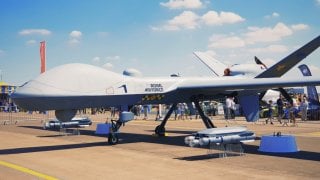Why Royal Air Force is Psyched for It's American Protector Drone
General Atomics is on a drone-making roll, and their success has attracted attention from all the way across the pond.
Here's What You Need to Remember: According to the UK Ministry of Defense, the UK’s Protector variant is intended for use primarily in “Intelligence, Surveillance, Targeting and Reconnaissance (ISTAR)” operations. Interestingly, the MoD also suggested that the Protector could see use in natural disaster scenarios in a search and rescue role.
In a press release, General Atomics announced that the company’s Protector drone completed its first flight. The Protector, a variant of the company’s SkyGuardian drone, is to be delivered to the United Kingdom’s Royal Air Force sometime in 2021 as a replacement for their fleet of Reaper unmanned aerial vehicles (UAVs).
According to General Atomics, the MQ-9 platform is the company’s most advanced remotely piloted aircraft system (RPAS), and is available in three configurations, as the SkyGuardian, a navy-variant called SeaGuardian, or as the Protector, made according to UK Ministry of Defense specifications.
General Atomics expects to deliver a total of sixteen of the United Kingdom-specific Protector variants to the Ministry of Defense by 2021 in a deal that is worth £65 million, or about $83 million that includes training and ground support equipment.
Though the MQ-9B can be delivered in a weaponized variant, it is primarily a surveillance and reconnaissance platform intended to conduct overhead observation. According to the UK Ministry of Defense, the UK’s Protector variant is intended for use primarily in “Intelligence, Surveillance, Targeting and Reconnaissance (ISTAR)” operations. Interestingly, the MoD also suggested that the Protector could see use in natural disaster scenarios in a search and rescue role.
“It was exciting to see the first flight of MQ-9B in the Protector configuration,” stated General Atomics President David Alexander. “The Royal Air Force has been a great partner for GA-ASI [General Atomics’ aeronautical division] for more than a decade. We’re thrilled to see this first customer aircraft completed and we look forward to delivering their Protector fleet and gaining more MQ-9B SkyGuardian customers in NATO and around the globe.”
Capabilities Plus Experience Equals Superiority—and American Domination
General Atomics’ MQ-9 is certified to NATO STANAG 4671, a standardization agreement among NATO member countries that allows unmanned aerial vehicles from one NATO member to be flown in another member’s airspace.
This certification standard compliance is one of the competitive edges that General Atomics’ drone fleet has, on top of pure performance and flight experience—the company claims over six million hours of flight experience under its belt.
Other, non-American initiatives, such as the European MALE RPAS, or Medium-Altitude, Long Endurance Remotely Piloted Aircraft System would struggle to compete with platforms like the Protector in terms of performance, as well as in terms of certification. The joint French-German design is still in its infancy, and though intended to break the American domination of the high-end drone market, is unlikely to do so thanks in part to diverging design requirements among the multinational project’s members.
Postscript
General Atomics is on a drone-making roll, having recently showcased their very first stealthy drone design that the company hopes will replace both the Predator and Reaper drones, as well as recently testing their small Sparrowhawk drone, designed to be released and recovered in air by airplanes or other drones. Other companies, like Bell Texton, are also fielding radical new UAV designs, suggesting that ever more radical drone designs could be expected in the future.
Caleb Larson is a Defense Writer with The National Interest. He holds a Master of Public Policy and covers U.S. and Russian security, European defense issues, and German politics and culture.
Image: Flickr

